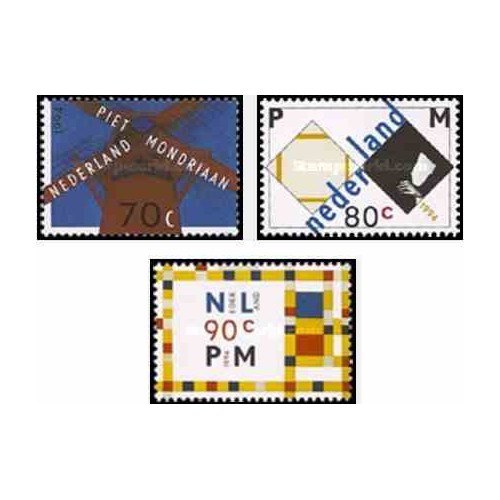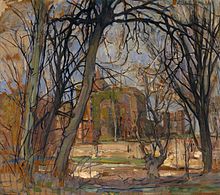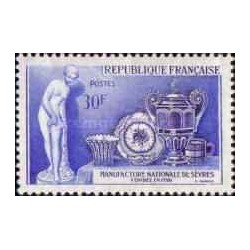- جدید
- ناموجود



توجه : درج کد پستی و شماره تلفن همراه و ثابت جهت ارسال مرسوله الزامیست .
توجه:حداقل ارزش بسته سفارش شده بدون هزینه پستی می بایست 100000 ریال باشد .
توجه : جهت برخورداری از مزایای در نظر گرفته شده برای مشتریان لطفا ثبت نام نمائید.
| Piet Mondrian | |
|---|---|
 Mondrian in 1899
|
|
| Born | Pieter Cornelis Mondriaan 7 March 1872 Amersfoort, Netherlands |
| Died | 1 February 1944 (aged 71) Manhattan, New York, United States |
| Nationality | Dutch |
| Education | Rijksakademie |
| Known for | Painting |
| Movement | De Stijl |
Pieter Cornelis "Piet" Mondriaan, after 1906 Mondrian (/ˈmɔːndriˌɑːn, ˈmɒn-/;[1]Dutch: [ˈpit ˈmɔndrijaːn], later [ˈmɔndrijɑn]; 7 March 1872 – 1 February 1944), was a Dutch painter.
Mondrian was a contributor to the De Stijl art movement and group, which was founded by Theo van Doesburg. He evolved a non-representational form which he termed neoplasticism. This consisted of white ground, upon which he painted a grid of vertical and horizontal black lines and the three primary colors.[2]
Mondrian's arrival in Paris from the Netherlands in 1911 marked the beginning of a period of profound change. He encountered experiments in Cubism and with the intent of integrating himself within the Parisian avant-garde removed an 'a' from the Dutch spelling of his name (Mondriaan).[3][4]


Mondrian was born in Amersfoort in the Netherlands, the second of his parents' children.[5] He was descended from Christian Dirkzoon Monderyan who lived in The Hague as early as 1670.[3] The family moved to Winterswijk in the east of the country when his father, Pieter Cornelius Mondriaan, was appointed Head Teacher at a local primary school.[6] Mondrian was introduced to art from a very early age. His father was a qualified drawing teacher, and, with his uncle, Fritz Mondriaan (a pupil of Willem Maris of the Hague School of artists), the younger Piet often painted and drew along the river Gein.[7]
After a strictly Protestant upbringing, in 1892, Mondrian entered the Academy for Fine Art in Amsterdam.[8] He already was qualified as a teacher.[6] He began his career as a teacher in primary education, but he also practiced painting. Most of his work from this period is naturalistic or Impressionistic, consisting largely of landscapes. These pastoral images of his native country depict windmills, fields, and rivers, initially in the Dutch Impressionist manner of the Hague School and then in a variety of styles and techniques that attest to his search for a personal style. These paintings are most definitely representational, and they illustrate the influence that various artistic movements had on Mondrian, including pointillism and the vivid colors of Fauvism.



On display in the Gemeentemuseum Den Haag are a number of paintings from this period, including such Post-Impressionist works as The Red Mill and Trees in Moonrise. Another painting, Evening (Avond) (1908), depicting a tree in a field at dusk, even augurs future developments by using a palette consisting almost entirely of red, yellow, and blue. Although Avond is only limitedly abstract, it is the earliest Mondrian painting to emphasize primary colors.

Mondrian's earliest paintings showing a degree of abstraction are a series of canvases from 1905 to 1908 that depict dim scenes of indistinct trees and houses reflected in still water. Although the result leads the viewer to begin focusing on the forms over the content, these paintings are still firmly rooted in nature, and it is only the knowledge of Mondrian's later achievements that leads one to search in these works for the roots of his future abstraction.
Mondrian's art was intimately related to his spiritual and philosophical studies. In 1908, he became interested in the theosophical movement launched by Helena Petrovna Blavatsky in the late 19th century, and in 1909 he joined the Dutch branch of the Theosophical Society. The work of Blavatsky and a parallel spiritual movement, Rudolf Steiner's Anthroposophy, significantly affected the further development of his aesthetic.[9] Blavatsky believed that it was possible to attain a more profound knowledge of nature than that provided by empirical means, and much of Mondrian's work for the rest of his life was inspired by his search for that spiritual knowledge.
Mondrian and his later work were deeply influenced by the 1911 Moderne Kunstkring exhibition of Cubism in Amsterdam. His search for simplification is shown in two versions of Still Life with Ginger Pot (Stilleven met Gemberpot). The 1911 version [10] is Cubist; in the 1912 version[11] the objects are reduced to a round shape with triangles and rectangles.
تشکر نظر شما نمی تواند ارسال شود
گزارش کردن نظر
گزارش ارسال شد
گزارش شما نمی تواند ارسال شود
بررسی خود را بنویسید
نظر ارسال شد
نظر شما نمی تواند ارسال شود

check_circle
check_circle















